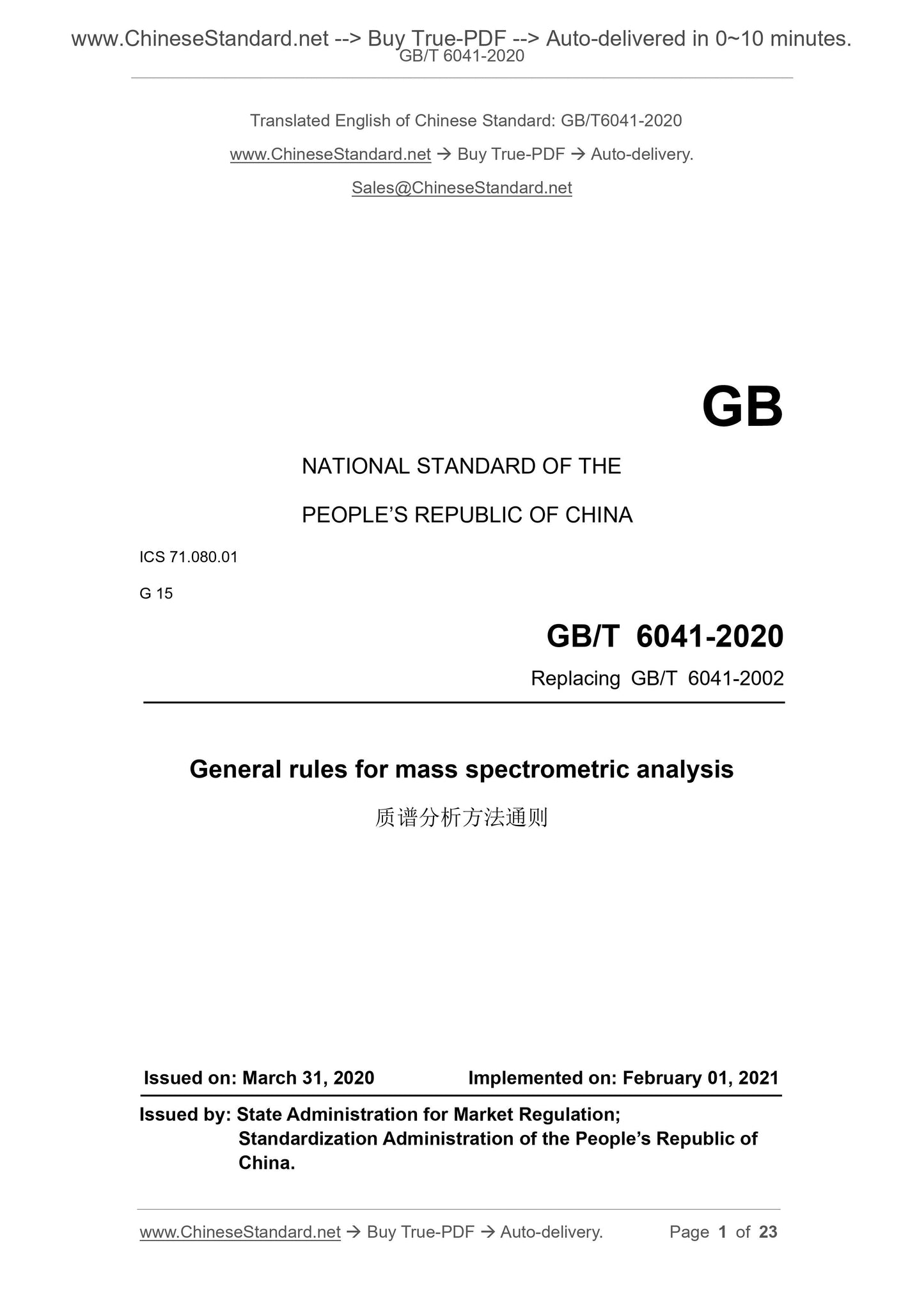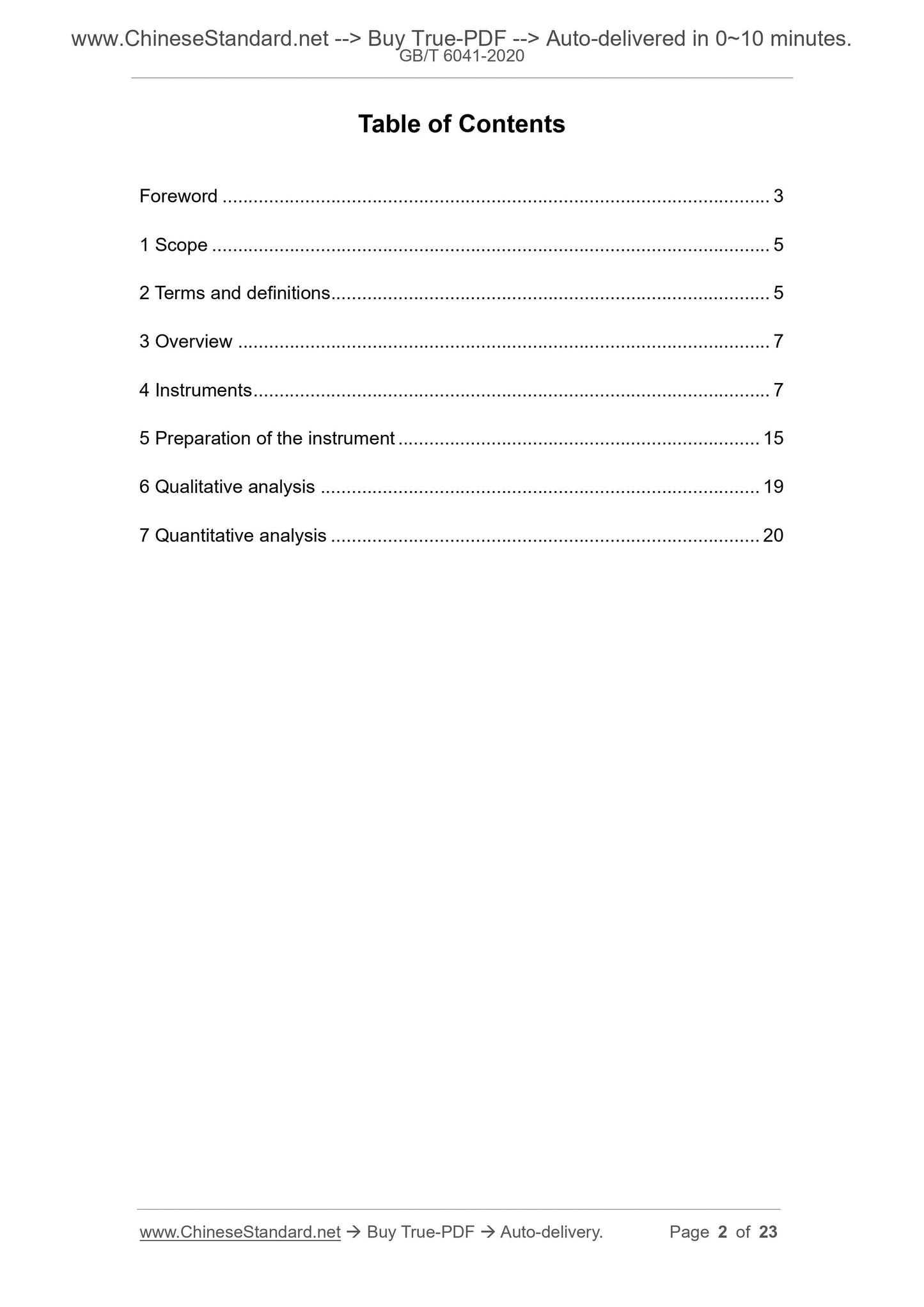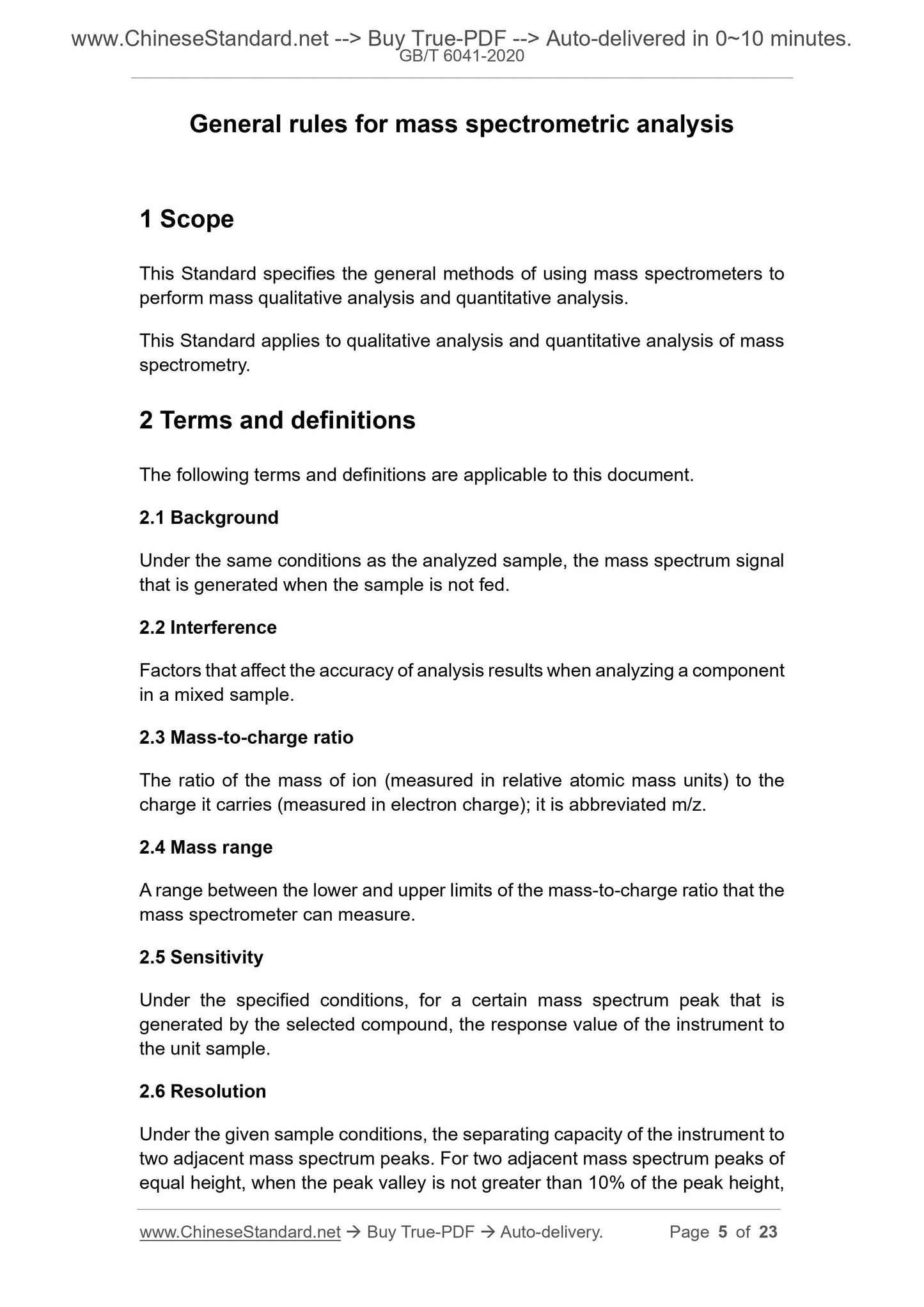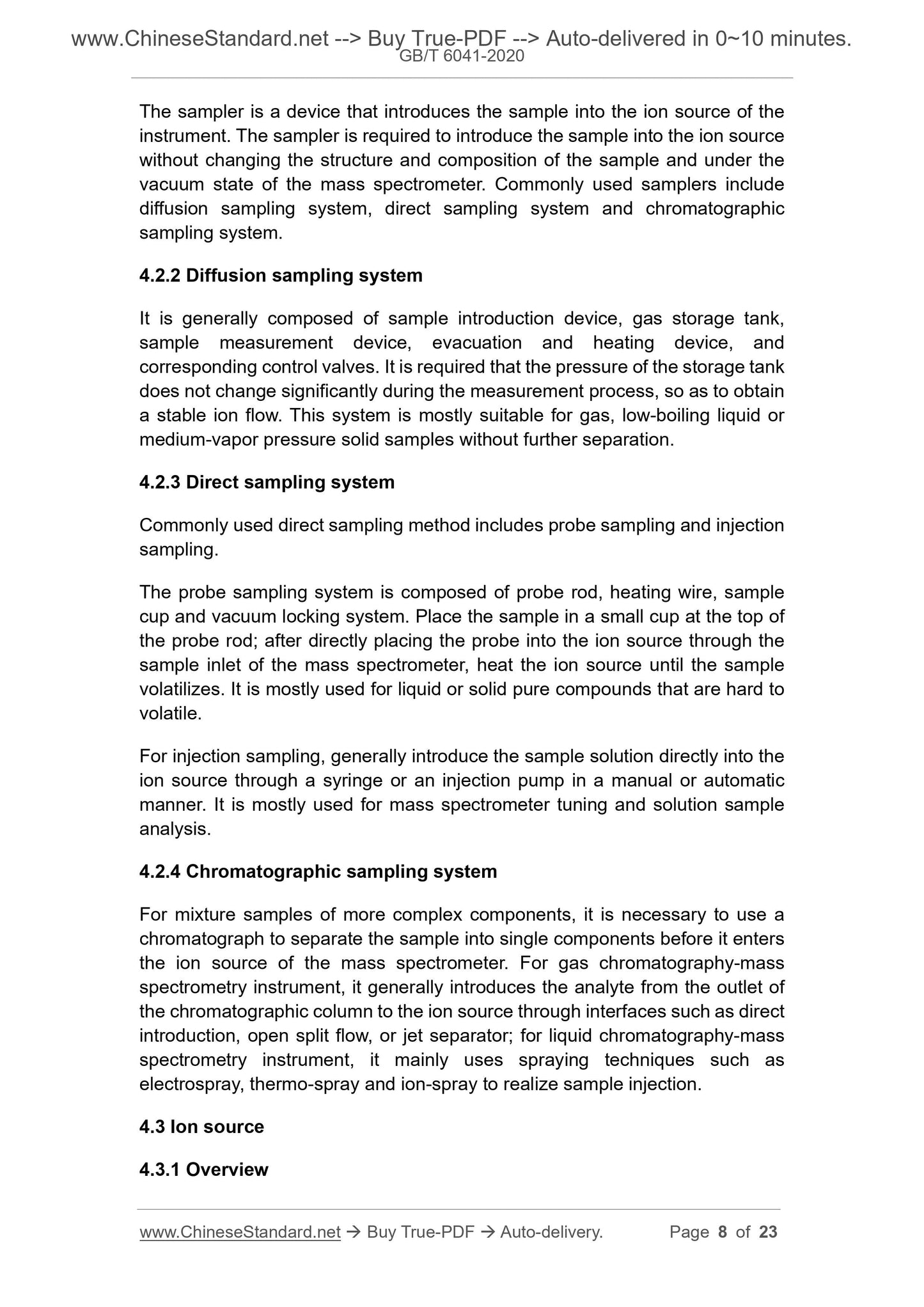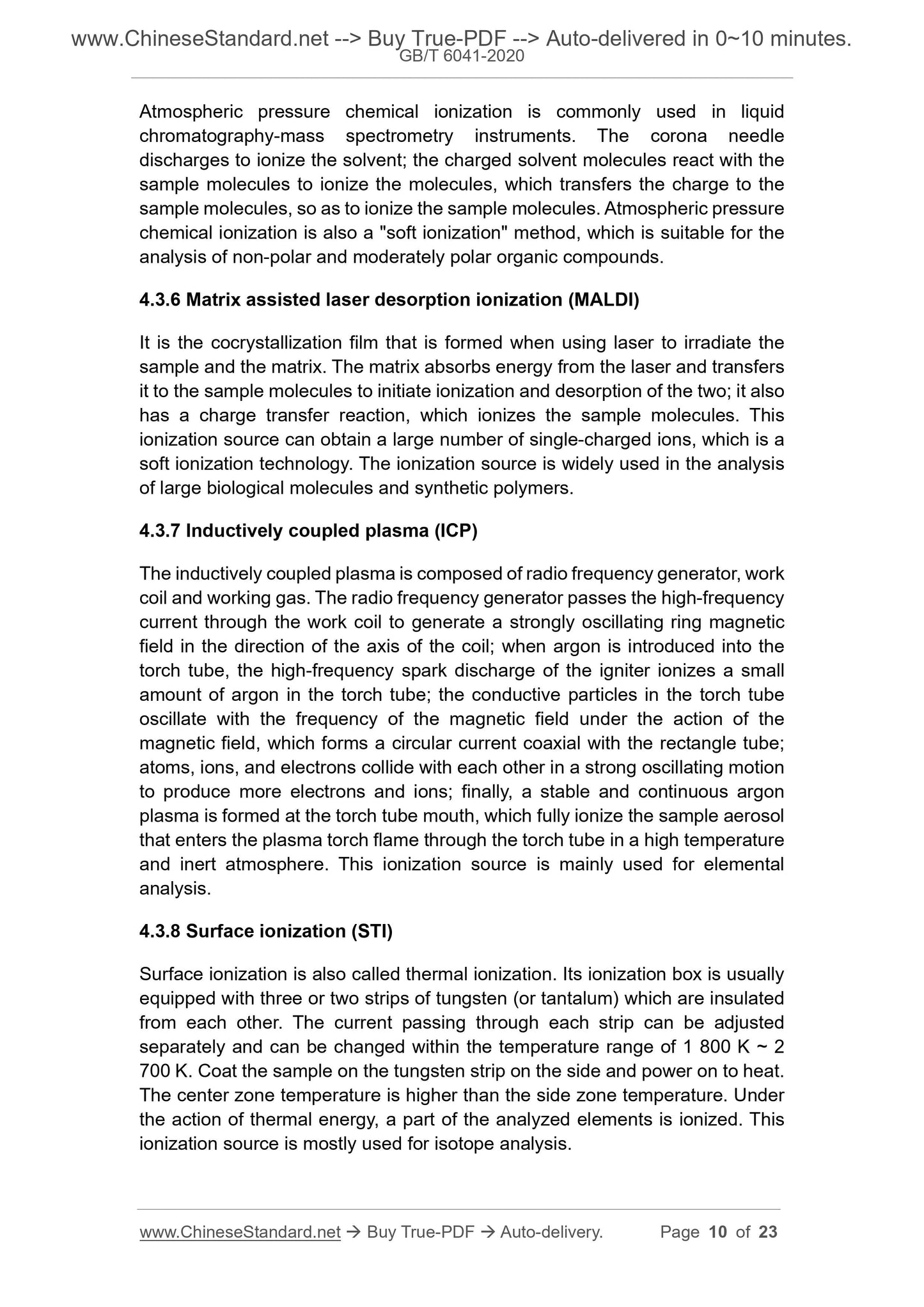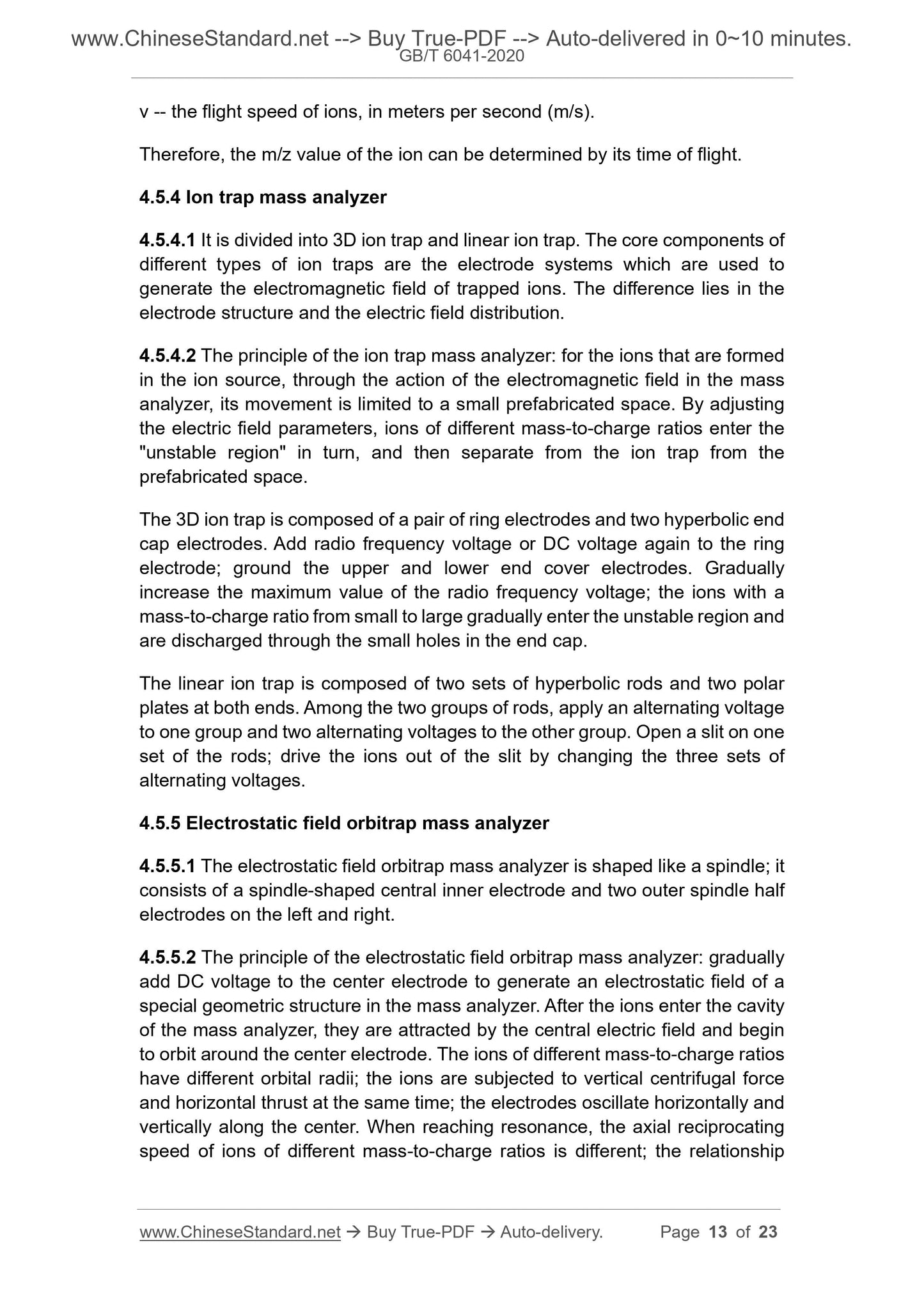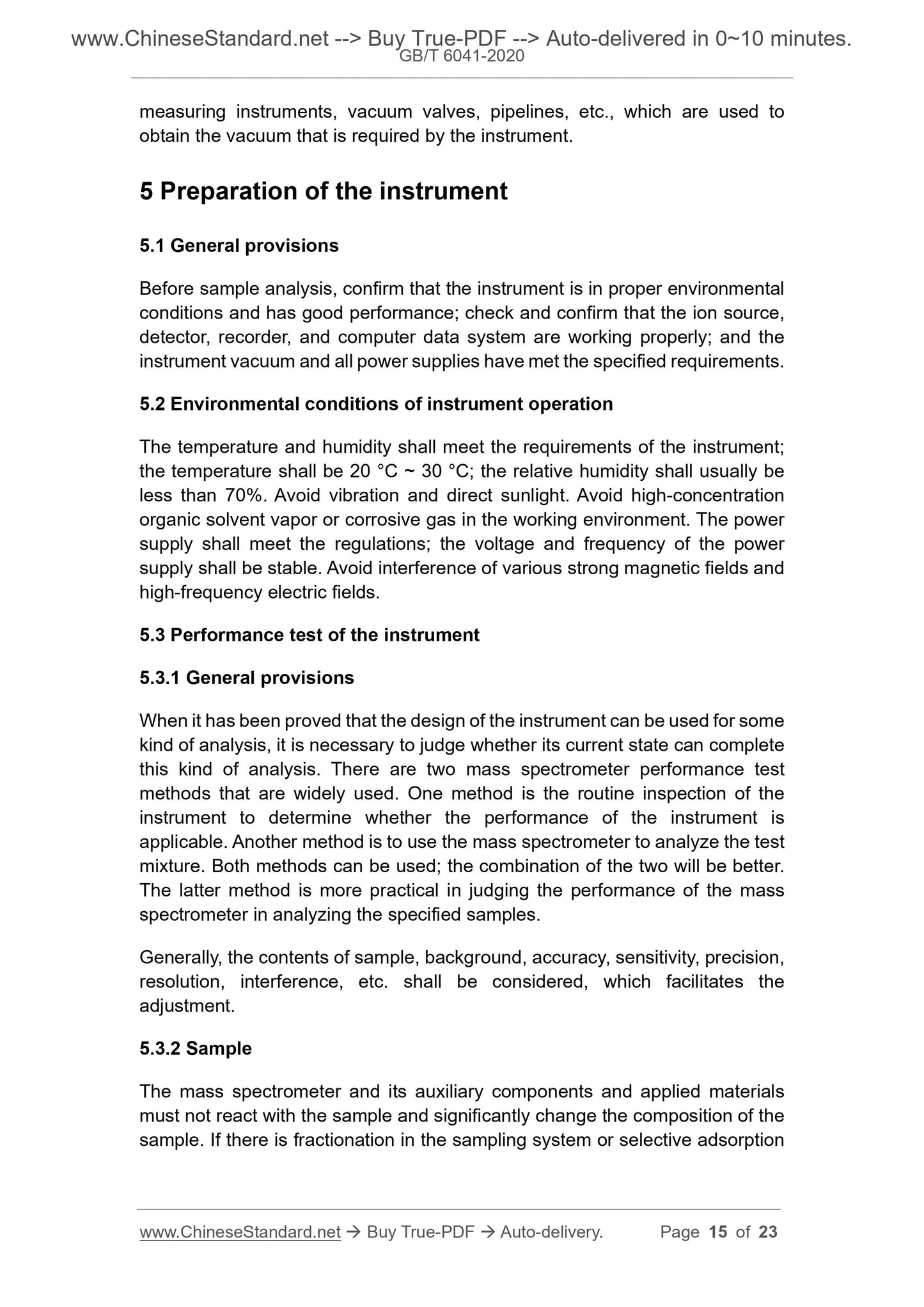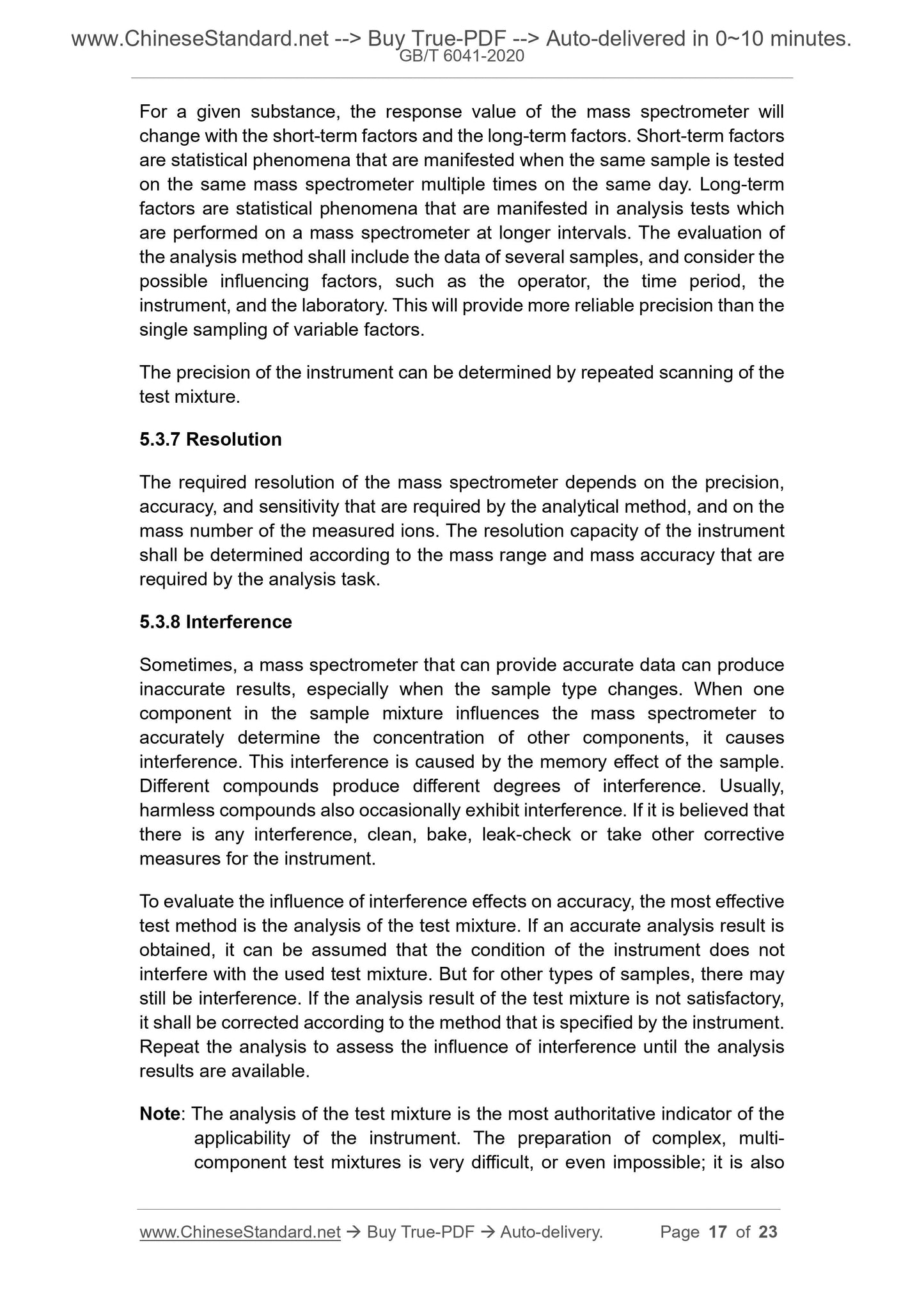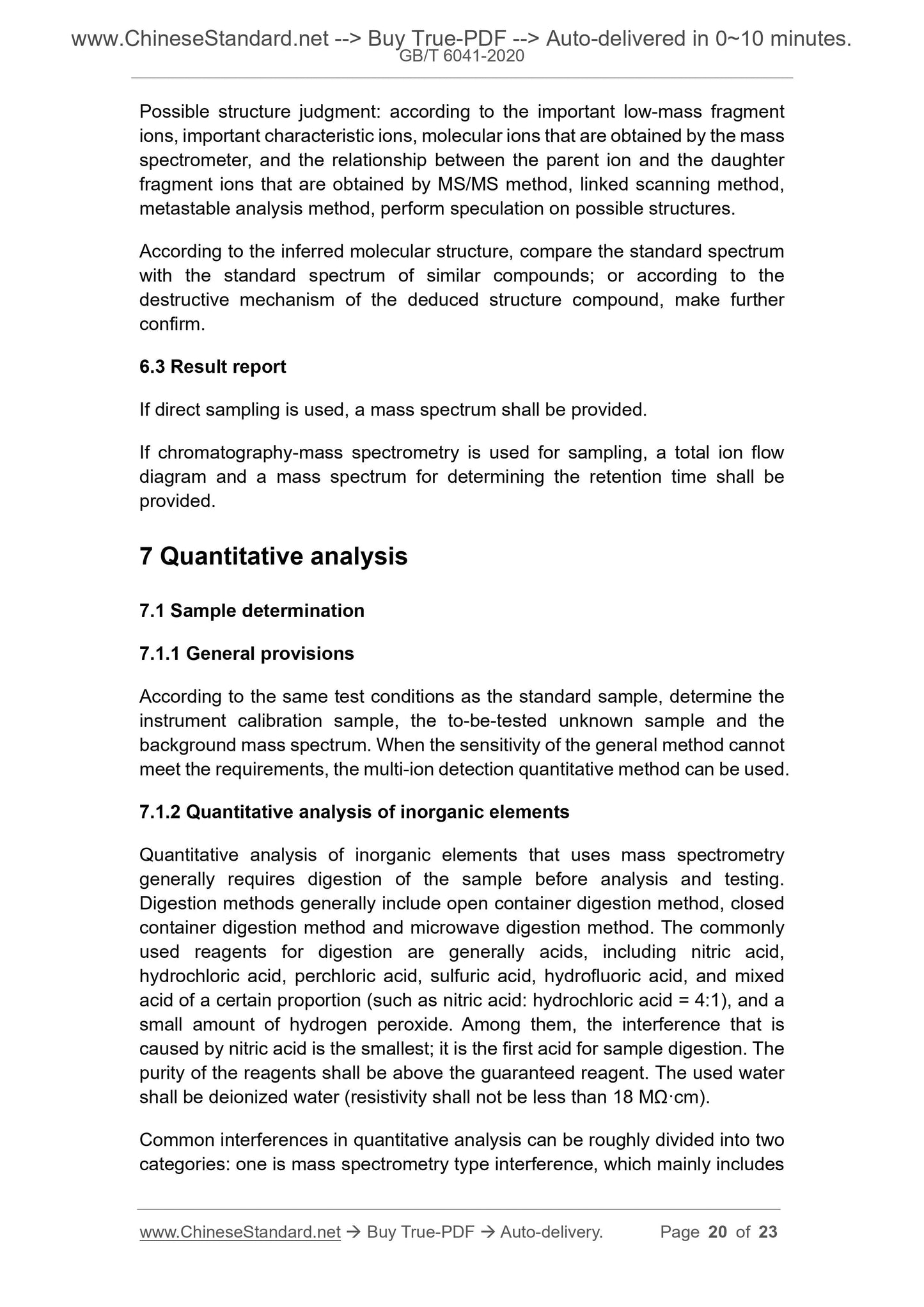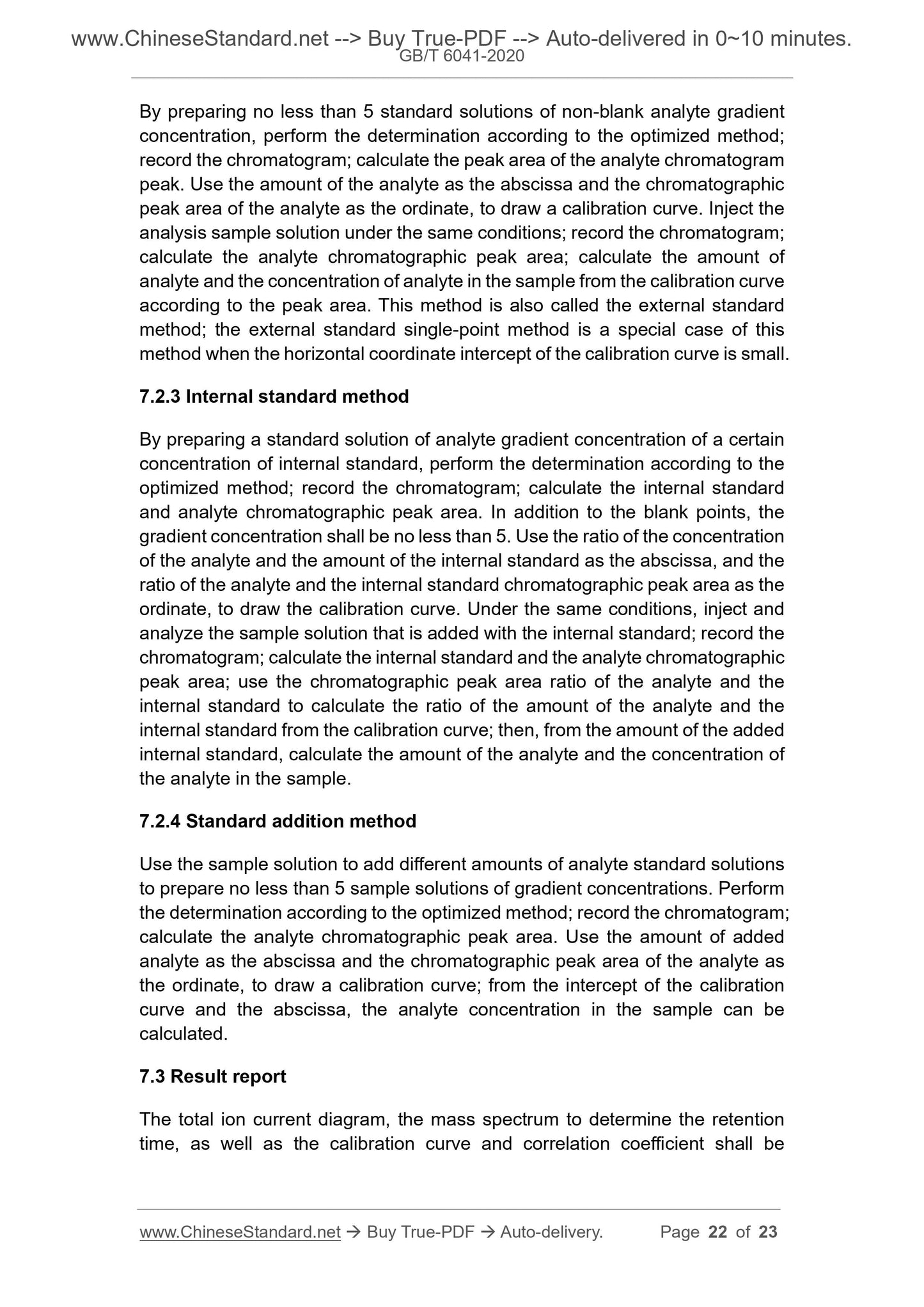1
/
of
10
www.ChineseStandard.us -- Field Test Asia Pte. Ltd.
GB/T 6041-2020 English PDF (GB/T6041-2020)
GB/T 6041-2020 English PDF (GB/T6041-2020)
Regular price
$175.00
Regular price
Sale price
$175.00
Unit price
/
per
Shipping calculated at checkout.
Couldn't load pickup availability
GB/T 6041-2020: General rules for mass spectrometric analysis
Delivery: 9 seconds. Download (& Email) true-PDF + Invoice.
Get Quotation: Click GB/T 6041-2020 (Self-service in 1-minute)
Historical versions (Master-website): GB/T 6041-2020
Preview True-PDF (Reload/Scroll-down if blank)
GB/T 6041-2020
NATIONAL STANDARD OF THE
PEOPLE’S REPUBLIC OF CHINA
ICS 71.080.01
G 15
Replacing GB/T 6041-2002
General rules for mass spectrometric analysis
ISSUED ON: MARCH 31, 2020
IMPLEMENTED ON: FEBRUARY 01, 2021
Issued by: State Administration for Market Regulation;
Standardization Administration of the People’s Republic of
China.
Table of Contents
Foreword ... 3
1 Scope ... 5
2 Terms and definitions ... 5
3 Overview ... 7
4 Instruments ... 7
5 Preparation of the instrument ... 15
6 Qualitative analysis ... 19
7 Quantitative analysis ... 20
General rules for mass spectrometric analysis
1 Scope
This Standard specifies the general methods of using mass spectrometers to
perform mass qualitative analysis and quantitative analysis.
This Standard applies to qualitative analysis and quantitative analysis of mass
spectrometry.
2 Terms and definitions
The following terms and definitions are applicable to this document.
2.1 Background
Under the same conditions as the analyzed sample, the mass spectrum signal
that is generated when the sample is not fed.
2.2 Interference
Factors that affect the accuracy of analysis results when analyzing a component
in a mixed sample.
2.3 Mass-to-charge ratio
The ratio of the mass of ion (measured in relative atomic mass units) to the
charge it carries (measured in electron charge); it is abbreviated m/z.
2.4 Mass range
A range between the lower and upper limits of the mass-to-charge ratio that the
mass spectrometer can measure.
2.5 Sensitivity
Under the specified conditions, for a certain mass spectrum peak that is
generated by the selected compound, the response value of the instrument to
the unit sample.
2.6 Resolution
Under the given sample conditions, the separating capacity of the instrument to
two adjacent mass spectrum peaks. For two adjacent mass spectrum peaks of
equal height, when the peak valley is not greater than 10% of the peak height,
The sampler is a device that introduces the sample into the ion source of the
instrument. The sampler is required to introduce the sample into the ion source
without changing the structure and composition of the sample and under the
vacuum state of the mass spectrometer. Commonly used samplers include
diffusion sampling system, direct sampling system and chromatographic
sampling system.
4.2.2 Diffusion sampling system
It is generally composed of sample introduction device, gas storage tank,
sample measurement device, evacuation and heating device, and
corresponding control valves. It is required that the pressure of the storage tank
does not change significantly during the measurement process, so as to obtain
a stable ion flow. This system is mostly suitable for gas, low-boiling liquid or
medium-vapor pressure solid samples without further separation.
4.2.3 Direct sampling system
Commonly used direct sampling method includes probe sampling and injection
sampling.
The probe sampling system is composed of probe rod, heating wire, sample
cup and vacuum locking system. Place the sample in a small cup at the top of
the probe rod; after directly placing the probe into the ion source through the
sample inlet of the mass spectrometer, heat the ion source until the sample
volatilizes. It is mostly used for liquid or solid pure compounds that are hard to
volatile.
For injection sampling, generally introduce the sample solution directly into the
ion source through a syringe or an injection pump in a manual or automatic
manner. It is mostly used for mass spectrometer tuning and solution sample
analysis.
4.2.4 Chromatographic sampling system
For mixture samples of more complex components, it is necessary to use a
chromatograph to separate the sample into single components before it enters
the ion source of the mass spectrometer. For gas chromatography-mass
spectrometry instrument, it generally introduces the analyte from the outlet of
the chromatographic column to the ion source through interfaces such as direct
introduction, open split flow, or jet separator; for liquid chromatography-mass
spectrometry instrument, it mainly uses spraying techniques such as
electrospray, thermo-spray and ion-spray to realize sample injection.
4.3 Ion source
4.3.1 Overview
Atmospheric pressure chemical ionization is commonly used in liquid
chromatography-mass spectrometry instruments. The corona needle
discharges to ionize the solvent; the charged solvent molecules react with the
sample molecules to ionize the molecules, which transfers the charge to the
sample molecules, so as to ionize the sample molecules. Atmospheric pressure
chemical ionization is also a "soft ionization" method, which is suitable for the
analysis of non-polar and moderately polar organic compounds.
4.3.6 Matrix assisted laser desorption ionization (MALDI)
It is the cocrystallization film that is formed when using laser to irradiate the
sample and the matrix. The matrix absorbs energy from the laser and transfers
it to the sample molecules to initiate ionization and desorption of the two; it also
has a charge transfer reaction, which ionizes the sample molecules. This
ionization source can obtain a large number of single-charged ions, which is a
soft ionization technology. The ionization source is widely used in the analysis
of large biological molecules and synthetic polymers.
4.3.7 Inductively coupled plasma (ICP)
The inductively coupled plasma is composed of radio frequency generator, work
coil and working gas. The radio frequency generator passes the high-frequency
current through the work coil to generate a strongly oscillating ring magnetic
field in the direction of the axis of the coil; when argon is introduced into the
torch tube, the high-frequency spark discharge of the igniter ionizes a small
amount of argon in the torch tube; the conductive particles in the torch tube
oscillate with the frequency of the magnetic field under the action of the
magnetic field, which forms a circular current coaxial with the rectangle tube;
atoms, ions, and electrons collide with each other in a strong oscillating motion
to produce more electrons and ions; finally, a stable and continuous argon
plasma is formed at the torch tube mouth, which fully ionize the sample aerosol
that enters the plasma torch flame through the torch tube in a high temperature
and inert atmosphere. This ionization source is mainly used for elemental
analysis.
4.3.8 Surface ionization (STI)
Surface ionization is also called thermal ionization. Its ionization box is usually
equipped with three or two strips of tungsten (or tantalum) which are insulated
from each other. The current passing through each strip can be adjusted
separately and can be changed within the temperature range of 1 800 K ~ 2
700 K. Coat the sample on the tungsten strip on the side and power on to heat.
The center zone temperature is higher than the side zone temperature. Under
the action of thermal energy, a part of the analyzed elements is ionized. This
ionization source is mostly used for isotope analysis.
v -- the flight speed of ions, in meters per second (m/s).
Therefore, the m/z value of the ion can be determined by its time of flight.
4.5.4 Ion trap mass analyzer
4.5.4.1 It is divided into 3D ion trap and linear ion trap. The core components of
different types of ion traps are the electrode systems which are used to
generate the electromagnetic field of trapped ions. The difference lies in the
electrode structure and the electric field distribution.
4.5.4.2 The principle of the ion trap mass analyzer: for the ions that are formed
in the ion source, through the action of the electromagnetic field in the mass
analyzer, its movement is limited to a small prefabricated space. By adjusting
the electric field parameters, ions of different mass-to-charge ratios enter the
"unstable region" in turn, and then separate from the ion trap from the
prefabricated space.
The 3D ion trap is composed of a pair of ring electrodes and two hyperbolic end
cap electrodes. Add radio frequency voltage or DC voltage again to the ring
electrode; ground the upper and lower end cover electrodes. Gradually
increase the maximum value of the radio frequency voltage; the ions with a
mass-to-charge ratio from small to large gradually enter the unstable region and
are discharged through the small holes in the end cap.
The linear ion trap is composed of two sets of hyperbolic rods and two polar
plates at both ends. Among the two groups of rods, apply an alternating voltage
to one group and two alternating voltages to the other group. Open a slit on one
set of the rods; drive the ions out of the slit by changing the three sets of
alternating voltages.
4.5.5 Electrostatic field orbitrap mass analyzer
4.5.5.1 The electrostatic field orbitrap mass analyzer is shaped like a spindle; it
consists of a spindle-shaped central inner electrode and two outer spindle half
electrodes on the left and right.
4.5.5.2 The principle of the electrostatic field orbitrap mass analyzer: gradually
add DC voltage to the center electrode to generate an electrostatic field of a
special geometric structure in the mass analyzer. After the ions enter the cavity
of the mass analyzer, they are attracted by the central electric field and begin
to orbit around the center electrode. The ions of different mass-to-charge ratios
have different orbital radii; the ions are subjected to vertical centrifugal force
and horizontal thrust at the same time; the electrodes oscillate horizontally and
vertically along the center. When reaching resonance, the axial reciprocating
speed of ions of different mass-to-charge ratios is different; the relationship
measuring instruments, vacuum valves, pipelines, etc., which are used to
obtain the vacuum that is required by the instrument.
5 Preparation of the instrument
5.1 General provisions
Before sample analysis, confirm that the instrument is in proper environmental
conditions and has good performance; check and confirm that the ion source,
detector, recorder, and computer data system are working properly; and the
instrument vacuum and all power supplies have met the specified requirements.
5.2 Environmental conditions of instrument operation
The temperature and humidity shall meet the requirements of the instrument;
the temperature shall be 20 °C ~ 30 °C; the relative humidity shall usually be
less than 70%. Avoid vibration and direct sunlight. Avoid high-concentration
organic solvent vapor or corrosive gas in the working environment. The power
supply shall meet the regulations; the voltage and frequency of the power
supply shall be stable. Avoid interference of various strong magnetic fields and
high-frequency electric fields.
5.3 Performance test of the instrument
5.3.1 General provisions
When it has been proved that the design of the instrument can be used for some
kind of analysis, it is necessary to judge whether its current state can complete
this kind of analysis. There are two mass spectrometer performance test
methods that are widely used. One method is the routine inspection of the
instrument to determine whether the performance of the instrument is
applicable. Another method is to use the mass spectrometer to analyze the test
mixture. Both methods can be used; the combination of the two will be better.
The latter method is more practical in judging the performance of the mass
spectrometer in analyzing the specified samples.
Generally, the contents of sample, background, accuracy, sensitivity, precision,
resolution, interference, etc. shall be considered, which facilitates the
adjustment.
5.3.2 Sample
The mass spectrometer and its auxiliary components and applied materials
must not react with the sample and significantly change the composition of the
sample. If there is fractionation in the sampling system or selective adsorption
For a given substance, the response value of the mass spectrometer will
change with the short-term factors and the long-term factors. Short-term factors
are statistical phenomena that are manifested when the same sample is tested
on the same mass spectrometer multiple times on the same day. Long-term
factors are statistical phenomena that are manifested in analysis tests which
are performed on a mass spectrometer at longer intervals. The evaluation of
the analysis method shall include the data of several samples, and consider the
possible influencing factors, such as the operator, the time period, the
instrument, and the laboratory. This will provide more reliable precision than the
single sampling of variable factors.
The precision of the instrument can be determined by repeated scanning of the
test mixture.
5.3.7 Resolution
The required resolution of the mass spectrometer depends on the precision,
accuracy, and sensitivity that are required by the analytical method, and on the
mass number of the measured ions. The resolution capacity of the instrument
shall be determined according to the mass range and mass accuracy that are
required by the analysis task.
5.3.8 Interference
Sometimes, a mass spectrometer that can provide accurate data can produce
inaccurate results, especially when the sample type changes. When one
component in the sample mixture influences the mass spectrometer to
accurately determine the concentration of other components, it causes
interference. This interference is caused by the memory effect of the sample.
Different compounds produce different degrees of interference. Usually,
harmless compounds also occasionally exhibit interference. If it is believed that
there is any interference, clean, bake, leak-check or take other corrective
measures for the instrument.
To evaluate the influence of interference effects on accuracy, the most effective
test method is the analysis of the test mixture. If an accurate analysis result is
obtained, it can be assumed that the condition of the instrument does not
interfere with the...
Delivery: 9 seconds. Download (& Email) true-PDF + Invoice.
Get Quotation: Click GB/T 6041-2020 (Self-service in 1-minute)
Historical versions (Master-website): GB/T 6041-2020
Preview True-PDF (Reload/Scroll-down if blank)
GB/T 6041-2020
NATIONAL STANDARD OF THE
PEOPLE’S REPUBLIC OF CHINA
ICS 71.080.01
G 15
Replacing GB/T 6041-2002
General rules for mass spectrometric analysis
ISSUED ON: MARCH 31, 2020
IMPLEMENTED ON: FEBRUARY 01, 2021
Issued by: State Administration for Market Regulation;
Standardization Administration of the People’s Republic of
China.
Table of Contents
Foreword ... 3
1 Scope ... 5
2 Terms and definitions ... 5
3 Overview ... 7
4 Instruments ... 7
5 Preparation of the instrument ... 15
6 Qualitative analysis ... 19
7 Quantitative analysis ... 20
General rules for mass spectrometric analysis
1 Scope
This Standard specifies the general methods of using mass spectrometers to
perform mass qualitative analysis and quantitative analysis.
This Standard applies to qualitative analysis and quantitative analysis of mass
spectrometry.
2 Terms and definitions
The following terms and definitions are applicable to this document.
2.1 Background
Under the same conditions as the analyzed sample, the mass spectrum signal
that is generated when the sample is not fed.
2.2 Interference
Factors that affect the accuracy of analysis results when analyzing a component
in a mixed sample.
2.3 Mass-to-charge ratio
The ratio of the mass of ion (measured in relative atomic mass units) to the
charge it carries (measured in electron charge); it is abbreviated m/z.
2.4 Mass range
A range between the lower and upper limits of the mass-to-charge ratio that the
mass spectrometer can measure.
2.5 Sensitivity
Under the specified conditions, for a certain mass spectrum peak that is
generated by the selected compound, the response value of the instrument to
the unit sample.
2.6 Resolution
Under the given sample conditions, the separating capacity of the instrument to
two adjacent mass spectrum peaks. For two adjacent mass spectrum peaks of
equal height, when the peak valley is not greater than 10% of the peak height,
The sampler is a device that introduces the sample into the ion source of the
instrument. The sampler is required to introduce the sample into the ion source
without changing the structure and composition of the sample and under the
vacuum state of the mass spectrometer. Commonly used samplers include
diffusion sampling system, direct sampling system and chromatographic
sampling system.
4.2.2 Diffusion sampling system
It is generally composed of sample introduction device, gas storage tank,
sample measurement device, evacuation and heating device, and
corresponding control valves. It is required that the pressure of the storage tank
does not change significantly during the measurement process, so as to obtain
a stable ion flow. This system is mostly suitable for gas, low-boiling liquid or
medium-vapor pressure solid samples without further separation.
4.2.3 Direct sampling system
Commonly used direct sampling method includes probe sampling and injection
sampling.
The probe sampling system is composed of probe rod, heating wire, sample
cup and vacuum locking system. Place the sample in a small cup at the top of
the probe rod; after directly placing the probe into the ion source through the
sample inlet of the mass spectrometer, heat the ion source until the sample
volatilizes. It is mostly used for liquid or solid pure compounds that are hard to
volatile.
For injection sampling, generally introduce the sample solution directly into the
ion source through a syringe or an injection pump in a manual or automatic
manner. It is mostly used for mass spectrometer tuning and solution sample
analysis.
4.2.4 Chromatographic sampling system
For mixture samples of more complex components, it is necessary to use a
chromatograph to separate the sample into single components before it enters
the ion source of the mass spectrometer. For gas chromatography-mass
spectrometry instrument, it generally introduces the analyte from the outlet of
the chromatographic column to the ion source through interfaces such as direct
introduction, open split flow, or jet separator; for liquid chromatography-mass
spectrometry instrument, it mainly uses spraying techniques such as
electrospray, thermo-spray and ion-spray to realize sample injection.
4.3 Ion source
4.3.1 Overview
Atmospheric pressure chemical ionization is commonly used in liquid
chromatography-mass spectrometry instruments. The corona needle
discharges to ionize the solvent; the charged solvent molecules react with the
sample molecules to ionize the molecules, which transfers the charge to the
sample molecules, so as to ionize the sample molecules. Atmospheric pressure
chemical ionization is also a "soft ionization" method, which is suitable for the
analysis of non-polar and moderately polar organic compounds.
4.3.6 Matrix assisted laser desorption ionization (MALDI)
It is the cocrystallization film that is formed when using laser to irradiate the
sample and the matrix. The matrix absorbs energy from the laser and transfers
it to the sample molecules to initiate ionization and desorption of the two; it also
has a charge transfer reaction, which ionizes the sample molecules. This
ionization source can obtain a large number of single-charged ions, which is a
soft ionization technology. The ionization source is widely used in the analysis
of large biological molecules and synthetic polymers.
4.3.7 Inductively coupled plasma (ICP)
The inductively coupled plasma is composed of radio frequency generator, work
coil and working gas. The radio frequency generator passes the high-frequency
current through the work coil to generate a strongly oscillating ring magnetic
field in the direction of the axis of the coil; when argon is introduced into the
torch tube, the high-frequency spark discharge of the igniter ionizes a small
amount of argon in the torch tube; the conductive particles in the torch tube
oscillate with the frequency of the magnetic field under the action of the
magnetic field, which forms a circular current coaxial with the rectangle tube;
atoms, ions, and electrons collide with each other in a strong oscillating motion
to produce more electrons and ions; finally, a stable and continuous argon
plasma is formed at the torch tube mouth, which fully ionize the sample aerosol
that enters the plasma torch flame through the torch tube in a high temperature
and inert atmosphere. This ionization source is mainly used for elemental
analysis.
4.3.8 Surface ionization (STI)
Surface ionization is also called thermal ionization. Its ionization box is usually
equipped with three or two strips of tungsten (or tantalum) which are insulated
from each other. The current passing through each strip can be adjusted
separately and can be changed within the temperature range of 1 800 K ~ 2
700 K. Coat the sample on the tungsten strip on the side and power on to heat.
The center zone temperature is higher than the side zone temperature. Under
the action of thermal energy, a part of the analyzed elements is ionized. This
ionization source is mostly used for isotope analysis.
v -- the flight speed of ions, in meters per second (m/s).
Therefore, the m/z value of the ion can be determined by its time of flight.
4.5.4 Ion trap mass analyzer
4.5.4.1 It is divided into 3D ion trap and linear ion trap. The core components of
different types of ion traps are the electrode systems which are used to
generate the electromagnetic field of trapped ions. The difference lies in the
electrode structure and the electric field distribution.
4.5.4.2 The principle of the ion trap mass analyzer: for the ions that are formed
in the ion source, through the action of the electromagnetic field in the mass
analyzer, its movement is limited to a small prefabricated space. By adjusting
the electric field parameters, ions of different mass-to-charge ratios enter the
"unstable region" in turn, and then separate from the ion trap from the
prefabricated space.
The 3D ion trap is composed of a pair of ring electrodes and two hyperbolic end
cap electrodes. Add radio frequency voltage or DC voltage again to the ring
electrode; ground the upper and lower end cover electrodes. Gradually
increase the maximum value of the radio frequency voltage; the ions with a
mass-to-charge ratio from small to large gradually enter the unstable region and
are discharged through the small holes in the end cap.
The linear ion trap is composed of two sets of hyperbolic rods and two polar
plates at both ends. Among the two groups of rods, apply an alternating voltage
to one group and two alternating voltages to the other group. Open a slit on one
set of the rods; drive the ions out of the slit by changing the three sets of
alternating voltages.
4.5.5 Electrostatic field orbitrap mass analyzer
4.5.5.1 The electrostatic field orbitrap mass analyzer is shaped like a spindle; it
consists of a spindle-shaped central inner electrode and two outer spindle half
electrodes on the left and right.
4.5.5.2 The principle of the electrostatic field orbitrap mass analyzer: gradually
add DC voltage to the center electrode to generate an electrostatic field of a
special geometric structure in the mass analyzer. After the ions enter the cavity
of the mass analyzer, they are attracted by the central electric field and begin
to orbit around the center electrode. The ions of different mass-to-charge ratios
have different orbital radii; the ions are subjected to vertical centrifugal force
and horizontal thrust at the same time; the electrodes oscillate horizontally and
vertically along the center. When reaching resonance, the axial reciprocating
speed of ions of different mass-to-charge ratios is different; the relationship
measuring instruments, vacuum valves, pipelines, etc., which are used to
obtain the vacuum that is required by the instrument.
5 Preparation of the instrument
5.1 General provisions
Before sample analysis, confirm that the instrument is in proper environmental
conditions and has good performance; check and confirm that the ion source,
detector, recorder, and computer data system are working properly; and the
instrument vacuum and all power supplies have met the specified requirements.
5.2 Environmental conditions of instrument operation
The temperature and humidity shall meet the requirements of the instrument;
the temperature shall be 20 °C ~ 30 °C; the relative humidity shall usually be
less than 70%. Avoid vibration and direct sunlight. Avoid high-concentration
organic solvent vapor or corrosive gas in the working environment. The power
supply shall meet the regulations; the voltage and frequency of the power
supply shall be stable. Avoid interference of various strong magnetic fields and
high-frequency electric fields.
5.3 Performance test of the instrument
5.3.1 General provisions
When it has been proved that the design of the instrument can be used for some
kind of analysis, it is necessary to judge whether its current state can complete
this kind of analysis. There are two mass spectrometer performance test
methods that are widely used. One method is the routine inspection of the
instrument to determine whether the performance of the instrument is
applicable. Another method is to use the mass spectrometer to analyze the test
mixture. Both methods can be used; the combination of the two will be better.
The latter method is more practical in judging the performance of the mass
spectrometer in analyzing the specified samples.
Generally, the contents of sample, background, accuracy, sensitivity, precision,
resolution, interference, etc. shall be considered, which facilitates the
adjustment.
5.3.2 Sample
The mass spectrometer and its auxiliary components and applied materials
must not react with the sample and significantly change the composition of the
sample. If there is fractionation in the sampling system or selective adsorption
For a given substance, the response value of the mass spectrometer will
change with the short-term factors and the long-term factors. Short-term factors
are statistical phenomena that are manifested when the same sample is tested
on the same mass spectrometer multiple times on the same day. Long-term
factors are statistical phenomena that are manifested in analysis tests which
are performed on a mass spectrometer at longer intervals. The evaluation of
the analysis method shall include the data of several samples, and consider the
possible influencing factors, such as the operator, the time period, the
instrument, and the laboratory. This will provide more reliable precision than the
single sampling of variable factors.
The precision of the instrument can be determined by repeated scanning of the
test mixture.
5.3.7 Resolution
The required resolution of the mass spectrometer depends on the precision,
accuracy, and sensitivity that are required by the analytical method, and on the
mass number of the measured ions. The resolution capacity of the instrument
shall be determined according to the mass range and mass accuracy that are
required by the analysis task.
5.3.8 Interference
Sometimes, a mass spectrometer that can provide accurate data can produce
inaccurate results, especially when the sample type changes. When one
component in the sample mixture influences the mass spectrometer to
accurately determine the concentration of other components, it causes
interference. This interference is caused by the memory effect of the sample.
Different compounds produce different degrees of interference. Usually,
harmless compounds also occasionally exhibit interference. If it is believed that
there is any interference, clean, bake, leak-check or take other corrective
measures for the instrument.
To evaluate the influence of interference effects on accuracy, the most effective
test method is the analysis of the test mixture. If an accurate analysis result is
obtained, it can be assumed that the condition of the instrument does not
interfere with the...
Share
